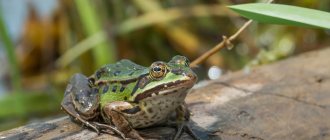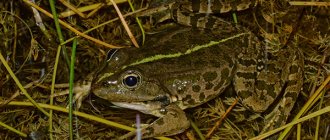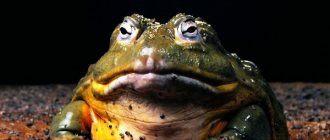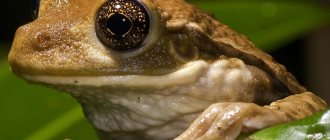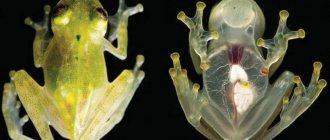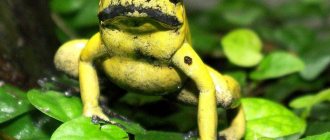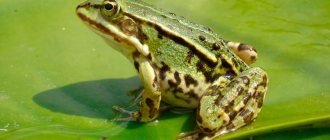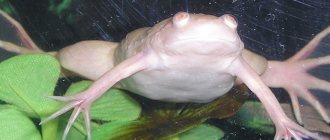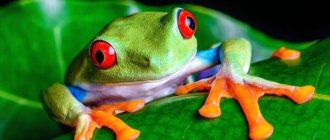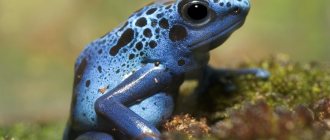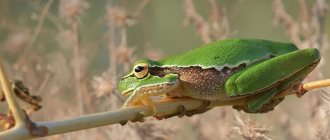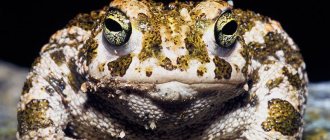Description
The African burrowing frog is one of the largest frogs in Africa. The bullfrog has a wide body with a short, rounded snout. The large mouth is equipped with sharp teeth. The hind limbs are very strong, with their help the frog digs deep holes. The species is quite aggressive and can bite painfully. Local residents consider the meat of this frog a delicacy. The throat of males is spotted yellow, while that of females is the color of cream. Young and growing frogs have a bright green back with contrasting white spots.
Water-carrier frog
Water frog (Pyxicephalus abspersus)
Class – Amphibians
Squad – Tailless
Family – Tree frogs
Rod – Litorii
Appearance
The length of adults is up to 25 cm. Females are usually smaller - up to 12 cm. Weight is up to 2 kg. The body is wide, the head is large and round with a wide mouth. There are sharp teeth in the mouth. Juvenile frogs have a bright green back with contrasting white spots. There may be a narrow light stripe or dark spots along the back. The skin is lumpy. The belly of young ones is white or light gray; with age it turns yellow. The throat of males is yellow with spots, while that of females is the color of cream. With age, the color darkens, becoming dirty, gray or marsh green. This coloration allows the frog to better camouflage itself in shallow water and on the shore among silt and grass. At high temperatures and abundant nutrition, they already reach a length of 15-18 cm at the age of one year. The hind limbs are very strong, with their help the frog digs deep holes.
Habitat
It lives in Eastern and Southern Africa (Malawi, Zambia, Nigeria, Somalia, Mozambique, Angola, South Africa, Kenya, Rhodesia, Tanzania and Sudan).
Inhabits savannas and woodlands, bushes along the banks of water bodies.
In nature
It leads a nocturnal terrestrial lifestyle (during the day it sits in shallow water or burrows into the coastal soil). During a drought, it buries itself in the silt, hibernates, and in order not to die from dehydration, it stores 0.5 liters of water in its bladder. This “flask” is often used by local residents. Baby frogs begin to feed on insects (crickets, for example), earthworms, and later move on to naked mice, baby frogs, then to larger mice and frogs. Unlike other relatives, which react only to moving food, the burrowing frog greedily rushes to stationary food. The jaws of this frog are very, very powerful and it is almost impossible to unclench them.
Reproduction
Frogs become sexually mature: males reach 22-25 cm in size (about 8 years), females reach 12 cm in size. The breeding season begins with the onset of the rainy season. Amphibians gather in shallow bodies of water (including bodies of water occupied by large animals, such as elephants) to reproduce. Males sing only during the breeding season. Young males begin to vocalize quite early. The “singing” of water carriers is loud, long-lasting and vaguely reminiscent of mooing, for which these amphibians have earned the name bullfrogs. The nightly cries of loving “pixies” are unlikely to cause delight in anyone, so adult males must be isolated from the bedroom. During breeding, amphibians become very territorial. The female lays 3000-4000 eggs in shallow water. The eggs are small (about 2 mm), black and white, enclosed in a jelly-like capsule about 4 mm in size. Incubation period is 2 days. The tadpoles are thick, gray-black. The eyes are located close to each other. Metamorphosis occurs after 18 days (young frogs grow up to 20 mm). Survival rates are quite low, with only about 20% surviving to reach puberty.
Captivity
The terrarium should be a large horizontal type or cubic type with a tight lid (bottom area of 600 sq. cm or more), with a pool (depth 5 - 15 cm) in which the entire animal can fit. Approximately 70 liters for 1 adult frog. There must be a thick layer of soil (15 - 20 cm), for example a mixture of sphagnum and small pebbles, expanded clay. Humidity 50-70%. Every day you need to spray the terrarium with a spray bottle. The temperature during the day is 23 - 25 C, at night - 21 - 23 C (you should not lower it lower, it can be harmful for the frog). The substrate should always be moist. Lighting - low power light bulb, fluorescent or incandescent, daylight hours 10-12 hours. You can design a terrarium to resemble a savannah area with many hidden places, hollow stones, and driftwood. The terrarium should be cleaned once every 2-3 weeks with light disinfectants. The water in the pool must be changed daily.
In nature, water bearers fall into a long summer hibernation, burrowing into the ground and surrounding themselves with a kind of cocoon. In the terrarium they are active all year round, so adult frogs need to regularly (once every 1-1.5 months) have a “fasting week”. In winter, the frog can hibernate; it will burrow into the substrate and will not emerge from the hole for several months. In the spring, you need to dig up the hole and get the frog out of it. The amphibian is placed in a dish with water. The frog wakes up very hungry. The frog spends a lot of time without moving, sitting in the corner of the terrarium. The frog jumps well and far and can accidentally bite a person on the hand, but it gets used to the person who cares for it. It is better to keep them alone in a terrarium, as there is a tendency towards cannibalism.
In captivity, these frogs greedily consume any animal food, including immobile food, from tweezers. You can give small pieces of lean red meat, small fish, mice, large insects, worms, and invertebrates. You cannot overfeed - it is harmful to health. Adult amphibians are fed once every 4-5 days, young ones once every 2 days. Powdered calcium and vitamins are given 2-3 times a week.
Life expectancy is up to 35 years.
Behavior
The African burrowing frog leads a terrestrial lifestyle. Active at night. During the day it sits in shallow water or burrows into the coastal soil. Spends most of the dry season deep in burrows (in a waterproof skin cocoon consisting of dead layers of skin), falling into long hibernation.
Keeping African burrowing toads in captivity
In captivity, frogs are fed any animal food using tweezers. You can treat them to lean red meat, small fish, mice, large insects, and worms. Excessive and frequent feeding is detrimental to the health of toads. The optimal number of approaches for adults is once every 4-5 days, young ones are fed once every two days. In addition, it is necessary to feed amphibians with vitamin preparations and calcium in powder form.
Burrowing frogs are not picky eaters, so they can be fed with a variety of animal foods.
Animal nutrition
What the ground toad eats partly depends on its habitat. The diet is summarized by a 100 percent protein base. Toads do not eat plant foods. Predation is limited to eating worms and insects.
The exception is the agi diet. Due to the poison, the amphibian also manages to infect small birds, rodents, and reptiles.
In the vast expanses of Russia, toads eat mainly fillies, ants, earwigs, slugs, caterpillars, click beetles, and mosquitoes. Most on the list are pests. Therefore, a ground toad in a garden or farmland can be useful.
However, amphibians are rarely greeted there with open arms. It's a matter of popular beliefs. Some believe that they take on her warts the moment they touch the animal. Others believe that toads represent the forces of darkness. Still others associate the heroine of the article with death.
To be fair, we note that there are also positive interpretations of the image of the earthen toad. In China, for example, it is a symbol of wealth. Celtic peoples call the toad the lord of the earth.
Description and features of the earthen toad
The ground toad in the photo and in reality is larger than a frog and has drier, rougher skin. It is covered with wart-like growths. Frogs do not have this, nor do they have the ability to catch insects in flight with lightning speed.
The toad picks them up with his tongue. But frogs have elongated hind legs. This allows animals to jump. Toads lack this ability. Additional differences from frogs are:
- loose body without clear contours
- head lowered to the ground
- an abundance of glands on the back that often produce poison
- dark skin with earthy undertones
- absence of teeth in the upper jaw
Ground toads have developed sexual dimorphism. Males are much smaller than females and have calloused first toes on their front paws. This helps determine the sex of the ground toad .
The calluses on the feet of male ground toads are overgrown skin glands. They help to stay on the partner's back during mating. Hence the hugging and grasping reflexes developed in males.
The ear glands are also enlarged in earthen toads. This applies to both sexes. The ear glands are called parotids.
The size of toads reaches up to 30 centimeters in length. In this case, the weight of an individual can be 2.3 kilograms. There are also miniature representatives of the order, about 3 centimeters long.
How to get rid of earth toad
Feeding on insects, toads do not disdain strongly smelling ones and are not afraid of contrastingly colored ones. Birds of prey ignore them. Therefore, there are benefits from the earthen toad. Amphibians do not cause harm or But for the sake of the benefits they bring, many species of toads have spread throughout the planet.
So yeah, for example, it came to Australia and the Hawaiian Islands. At the end of the day, the settlers were released into the cane fields. The toads quickly destroyed the pests, preserving the crop harvest.
Despite the benefits of the heroine of the article, many people think how to get rid of the earthen toad . It's a matter of beliefs, stereotypes and simply aversion to amphibians. Methods for exterminating toads include:
- keeping poultry that will eat amphibians
- clearing the area of fallen leaves, boards, bark and other places where toads can hide
- periodically mowing the grass needed by toads for shading and shelter
The only way that toads actually harm vegetable gardens is through burrows. When making them for shelter, amphibians can touch the roots of plants. Some gardeners complain that their cucumbers and tomatoes are literally falling through the cracks. However, for such a result there must be a lot of toads. Often, only a few individuals live in one area.
Reproduction and lifespan
The answer to the question of how ground toads reproduce in Russia is clear - by external fertilization. The egg is released outside the body. There the male fertilizes. The eggs of toads are their eggs. Its females lay it in a pond. The males fertilize the eggs there.
Toads choose puddles, ponds, ditches, and river backwaters as reservoirs for spawning. Outside Russia, there are species that lay eggs in rapids. In this case, the tadpoles are equipped with suckers. They are located on the abdomen. With the help of suction cups, tadpoles are attached to algae, bottom stones, and snags.
Abroad there are also ground toads that lay their eggs outside bodies of water. Representatives of the Philippine species place their eggs in the axils of tree leaves. Toads choose greenery at a height of several meters.
Exceptions among toads are also those that use a cycle of internal fertilization. These are viviparous species. Their eggs develop in dilated oviducts. Interestingly, all viviparous toads are miniature, not exceeding 3 centimeters in length.
How long earth toads live also depends on the species. The majority limit is 25 years, with a minimum of 5 years. However, representatives of large species lived up to 36 years.
Listen to the voice of the African burrowing frog
The female burrowing frog lays 3000-4000 small black and white eggs enclosed in a jelly-like capsule. After 2 days, plump gray-black tadpoles emerge from the eggs. Metamorphosis occurs after 2.5 weeks, but only 20% of them will become sexually mature.
Burrowing frogs are quite aggressive creatures. During the breeding season, their behavior should be closely monitored.
To breed in captivity, these frogs should be placed in a common terrarium during the breeding season.
The process of breeding these amphibians is very complex and requires the administration of gonadotropic injections to the animals. There should be only one female and only one male in one terrarium, and it is important to ensure that the future “father” does not eat the female.
If you find an error, please select a piece of text and press Ctrl+Enter.
General health and behavioral problems
Although these frogs live for many years, they do not require much health care. If the environment is warm and humid enough, your frog should not have any skin problems.
However, bacterial and fungal infections of the skin and eyes are common in pets that live in less than ideal conditions.
Intestinal parasites can also be a problem with pet bullfrogs. If the tank temperature is high enough and the frog is still not eating well, take it to an experienced exotics veterinarian to rule out parasitism. An annual stool sample should also be checked.
Also, be on the lookout for ammonia poisoning. This occurs when a frog is left in an enclosure with too much waste.
Symptoms include lethargy, uncoordinated movements and blurred eyes. Death may occur within a few days. Clean the tank as soon as possible and call a veterinarian.
Substrate
The substrate is the material that covers the bottom of your frog's enclosure. This helps maintain humidity in the environment and can make the aquarium feel more like the animal's natural habitat.
Coconut fiber, made from coconut husks, is a good option as a substrate.
Another option is peat moss. The ideal option is an organic product that retains some heat and moisture. Avoid using soil treated with insecticides or other chemicals.
Make sure it is clean and change it frequently. African bullfrogs are known to eat the substrate in their cages, so any material covering the enclosure should be easily digestible.
What do frogs eat?
